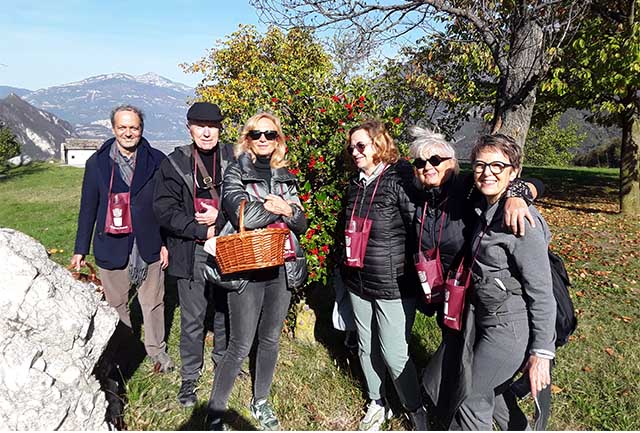
Salve! Buona giornata! Buongiorno! Come sta? Come stai?? Come state??? Oggi scopriamo di più sui due modi fondamentali di rivolgersi ad una persona che dà forma alle interazioni sociali in Italia – la forma formale del “LEI” e l’amichevole “TU.”
Hello! Good day! Good morning! How are you? How are you?? How are you??? Today we will discover more about the two fundamental ways of addressing a person that shape all social interactions in Italy – the formal form of the “LEI” and the friendly “TU.”

In italiano, ci sono due modi di esprimere “YOU. ”
In Italian, there are two ways of expressing ”YOU.“
“TU” viene utilizzato con qualcuno che conosci in base al nome, come un bambino, un amico, la famiglia, e gli animali domestici.
“TU” is used with someone you know on a first-name basis, such as a child, a friend, your family, and your pets.
“LEI” è usato con sconosciuti, nuovi conoscenti, colleghi, una persona più anziana o qualcuno in una posizione di autorità.
“LEI” is used with strangers, new acquaintances, colleagues, someone older than you, or someone in a position of authority.
Oggi passeggeremo per una piccola città italiana per imparare le differenze tra il modo formale italiano di rivolgersi alle persone e il modo informale di parlare alle persone.
Today we will stroll through a small Italian town to learn the differences between the formal Italian way of addressing people and the informal way of talking to people.

Nel centro della città, passando un negozio di scarpe, tu vedi la signora Isabella, che guarda con interesse una mostra di scarpe nella vetrina. È una signora anziana, molto raffinata, con un’aria di grazia e di dignità. L’hai incontrata sola una volta in presenza di un architetto che ha apportato modifiche alla villa che hai acquistato fuori città. Non conosci molto bene la signora Isabella. Tuttavia, sei colpito dal fatto che possa far risalire la sua discendenza alla famiglia Medici e che comandi l’attenzione come regina reale al centro della sua corte.
In the city center, as you pass by a shoe store, you see Signora Isabella, who is looking with interest at a display of shoes in the shop’s window. She is an elderly, very refined lady with an air of grace and dignity. You met her once in the presence of an architect making changes to the villa you purchased outside of town. You don’t know Signora Isabella very well. Still, you are impressed that she can trace her lineage to the Medici family and commands attention like a regal queen amidst her court.
Mentre la signora Isabella alza lo sguardo, sorride e ti saluta con un cenno gentile e usa il modo formale di rivolgersi alle persone in Italia per mostrare rispetto.
As Signora Isabella looks up, she smiles and greets you with a gentle nod and uses the formal mode of address that people in Italy used to show respect.
Signora Isabella: ”Buongiorno! Lei è il signor Rossi, giusto?
“Good morning! You’re Mr. Rossi, right?
You: Sì. Lei ricorda bene. E Lei è la Signora Isabella Bianchi?
Yes, you remember well. And you’re Mrs. Isabella Bianchi?
Signora Isabella: Esattamente! È un piacere incontrarLa di nuovo, signor Rossi. Exactly! Nice to meet you again, Mr Rossi.
You: Il piacere è tutto mio, signora Bianchi. Come sta?
The pleasure is mine, Mrs. Bianchi; how are you?
Signora Isabella: Sto bene, grazie. E Lei?
I’m fine, thank you. What about you?
You: Anch’io sto bene, grazie.
I, too, am well, thanks.
Il cellulare della signora Bianchi squilla. Signora Bianchi’s cell phone rings.
Signora Isabella: Mi scusi, signor Rossi. Dovrei rispondere alla chiamata. Ma visto che siamo vicini di casa, spero di avere l’opportunità di parlare ancora con Lei in futuro.
Excuse mi, Signor Rossi. I should take this call. But since we are neighbors, I hope to have the opportunity to talk to you again in the future.
You: Assolutamente. Non vedo l’ora di approfondire la nostra conoscenza. Buona giornata, signora Bianchi.
Absolutely. I look forward to knowing you better. Good day, Mrs. Bianchi.
Signora Bianchi: Grazie, altrettanto a Lei, signor Rossi. A presto!
Thank you, the same to you signor Rossi, see you soon.
Questa è l’essenza del modo formale di parlare in Italia. Si tratta di una danza linguistica di riverenza riservata a persone stimate come gli anziani, i professionisti, o coloro con i quali si deve ancora stabilire familiarità. Come si vede nella conversazione di cui sopra, il modo formale di indirizzo utilizza verbi coniugati in terza persona singolare.
This is the essence of the formal mode of address in Italy. It is a linguistic dance of reverence reserved for esteemed individuals such as elders, professionals, or those with whom one has yet to establish familiarity. As seen in the conversation above, the formal mode of address uses verbs conjugated in the third person singular.

Proseguendo lungo Corso Italia in centro, tu incontri Paolo, un’anima piena di energia e calore. Hai conosciuto Paolo la prima volta che sei arrivato ad Arezzo tre anni fa, e da allora siete diventati cari amici.
As you continue up Corso Italia in Arezzo, you run into Paolo, a spirited soul bursting with energy and warmth. You met Paola the first time you came to Arezzo three years ago, and since then, you’ve become the best of friends.
Paolo sorride ampiamente, ti bacia su entrambe le guance e poi, come se non bastasse, ti dà un pugno giocoso sul braccio e procede a parlare con te nell’affettuosa modalità “tu” di indirizzo che indica familiarità e vicinanza.
Paolo smiles broadly, kisses you on both cheeks and then, as if that weren’t enough, gives you a playful punch on the arm and proceeds to talk with you in the affectionate “tu” mode of address that indicates familiarity and closeness.
Paolo: Ciao, amico! Come stai?
Hi, man! How are you?
You: Ciao, ciccio! Sto benissimo, grazie! E tu?
Hi, dude! I’m fine, thanks! What about you?
Paolo: Fantastico! Sai cosa mi farebbe piacere adesso?
Great! Do you know what I’d like right now?
You: Dimmi, non vedo l’ora di saperlo!
Tell me; I can’t wait to find out!
Paolo: Prendiamoci un bel bicchiere di vino insieme. Che ne dici?
Let’s have a nice glass of wine together. What do you say?
You: Che idea meravigliosa! Andiamo a gustarci un vino insieme.
What a great idea! Let’s enjoy some wine together.
Paolo: Perfetto! Conosciamo un posto accogliente qui vicino. Ti va anche mangiare una pizza?
Perfect! We know a great place nearby. Would you like also like to eat a pizza?
You: Certo! Sono pronto per tutto, e ho fame da lupo!
Sure! I’m down for anything and hungry as a horse!
Paolo: Anche, io. E non vedo l’ora di sentire gli ultimi pettegolezzi e com’è andato il tuo appuntamento con Maria ieri sera!
Me too. And I can’t wait to hear the latest gossip and how your date went with Maria last night!

Hai capito le sfumature delle conversazioni, prima con la signora Isabella e poi con Paolo?
Have you understood the nuances in the conversations, first with Signora Isabella and then Paolo?
Quando incontriamo persone che abbiamo appena conosciuto, persone che non conosciamo bene e che desiderano mostrare rispetto, “diamo del Lei.” D’altra parte, usiamo la forma affettuosa “TU” quando parliamo e interagiamo con amici di lunga data. Ci troviamo in ambiente dove possiamo ridere, scherzare e raccontare storie intime.
When encountering individuals we have just met or don’t know very well and wish to show respect; we use the “LEI” mode of address.” On the other hand, we use the affectionate “TU” form when talking and interacting with long-time friends. We find ourselves in a relaxed atmosphere where we can laugh, joke, and tell intimate stories.
Forming the “TU” mode of address.
Verbs are conjugated in the second person singular.
Note: It’s important to note that “voi” is the plural form of “tu” used when addressing two or more people in an informal setting.
For example:
Marco, sei pronto? – Marco, are you ready?
Maria, vuoi qualcosa da bere? – Maria, do you want something to drink?
Forming the “LEI” mode of address.
Verbs are conjugated using the third person singular.
Note: The Italian formal YOU (which is “Lei”) and the subject pronoun SHE (which is also “lei”) should never be confused. The first is only used to address someone (one person) formally, and the second is used in a statement to refer to “SHE” in the third person.
For example:
Signora, è pronta? – Are you ready, ma’m?
Lei è pronta – She is ready!
To form the third person plural in the formal mode of address, the pronoun “Loro” should be used. However, the use of “loro” as a formal form of address has declined recently and is not as common as it once was. Therefore, using “voi” in formal and informal situations is more natural.
Here is a table to show conjugations of “informal TU” and “formal LEI”
using stare, essere, abitare, avere, andare, prendere, volere, mangiare.
INFORMAL TU
Come stai?
Di dove sei?
Dove abiti?
Che lingue parli?
Quanti anni hai?
Dove vai?
Cosa prendi?
Cosa vuoi?
Cosa mangi?
FORMAL LEI
Come sta?
Di dove è?
Dove abita?
Che lingua parla?
Quanti anni ha?
Dove va?
Cosa prende?
Cosa vuole?
Cosa mangia?
English Translation
How are you?
Where are you from?
Where do you live?
What language do you speak?
How old are you
Where are you going?
What are you buying (taking)?
What do you want?
What are you eating?
Forming the “LEI” FORMAL IMPERATIVE.
The Formal Imperative mode is the same as the third person singular of the present subjunctive (whether regular or irregular, and whether it’s an —are, —ere, or —ire verb).
Take, for example, the verb SCUSARE = to apologize.
Scusa (scusami) = present tense INFORMAL IMPERATIVE second person singular “TU” form ——> Scusa, hai dei soldi? (Excuse me, do you have any money?)
Scusi (mi scusi) = present tense FORMAL IMPERATIVE present third person singular “LEI” Form ——> Scusi, mi perdona per arrivare tardi? (I’m sorry, can you forgive me for arriving late?)
Scusi (ti scusi) = present tense CONGIUNTIVO second person singular “TU” form ——> Che tu ti scusi per il tuo comportamento. (May you apologize for your behavior.)
Check out a previous post to review how to form the Imperative “tu” and “Lei” forms.

Cosa succede quando due persone vogliono smettere di usare il formale “LEI” e usare invece l’informale “TU?”
What happens when two people wish to stop using the formal “LEI” mode of address and want to use the informal “TU” form?
Diamo un’occhiata a due persone chiamate Sofia e Luca. Un giorno i loro percorsi si incrociano in Piazza Grande, e si incontrano per la prima volta. Sofia si rivolge a Luca usando il formale “Lei” che mostra grazia e cortesia. “Come sta? Signore?
Let’s take a look at two people called Sofia and Luca. One day their paths cross in Piazza Grande, and they meet for the first time. Sofia addresses Luca using the formal “Lei” form with grace and politeness. “Come sta? Signore?
Lucca ricambia con un cenno rispettoso e si presenta anche formalmente. “Mi chiamo Luca Signorelli. È Lei? Come si chiama?” La danza della formalità ha inizio!
Lucca reciprocates with a respectful nod and presents himself formally as well. “Mi chiamo Luca Signorelli. È Lei? Come si chiama?” The dance of formality begins!
Sofia e Luca continuano a passarsi accanto contemporaneamente in Piazza Grande, e un giorno Luca invita Sofia a condividere un caffè con lui. “A Lei piacerebbe prendere un caffè con me?”
Sofia and Luca continue to pass by one another simultaneously in Piazza Grande, and one day Luca invites Sofia to share a coffee with him. “Would you like to get a coffee with me?

Poi la prossima volta che i due si incontrano, Sofia invita Luca a prendere un caffè con lei. Iniziano un’amicizia. Dopo qualche settimana, e diversi caffè dopo, mentre sorseggia il suo espresso Sofia dà scherzosamente una gomitata al braccio di Luca e dice, “Conosciamo già da un bel po’ Luca, perché non ci diamo del tu?”
Then, the next time the two meet, Sofia invites Luca to have a coffee with her. They begin a friendship. After a week or two, and several coffees later, as she sips her espresso Sofia playfully nudges Luca’s arm and says, “We’ve known each other for a while now, Luca, perché non ci diamo del tu?” Translation: “Luca, why don’t we switch to ‘tu’?”
Gli occhi di Luca si spalancano di gioia e un ghigno malizioso balla sulle sue labbra. “Ma Certo, Sofia! Sarebbe un piacere! Pensavo non me l’avresti mai chiesto!”“
Luca’s eyes widen with delight and a mischievous grin dances upon his lips. “Certainly, Sofia! It would be a pleasure! I thought you’d never ask!”
Semplicemente, Sofia e Luca intraprendono un viaggio di familiarità e vicinanza. Hanno perso l’armatura formale di “Lei” e abbracciano il caldo abbraccio di “tu.” Iniziano a parlarsi con termini accattivanti come “Amico/Amica,” “Sciocco/Sciocca,” “Tesoro” e altre espressioni che mostrano la loro profonda connessione e affetto. Con ogni “tu” scambiato, Sofia e Luca passo ulteriormente in un regno di fiducia e comfort.
As simple as that, Sofia and Luca embark on a journey of familiarity and closeness. They shed the formal armor of “Lei” and embrace the warm embrace of “tu.” They begin addressing each other with endearing terms like “Friend,” “Silly or Stupid” and “Darling” and other expressions that reflect their deep connection and affection. With every “tu” exchanged, Sofia and Luca step further into a realm of trust and comfort.

Ora, armati della conoscenza di queste sfumature linguistiche, possano i vostri incontri in Italia essere più ricchi mentre usate la forma “LEI” per comunicare rispetto e ammirazione e la forma “TU” per formare amicizie durature. E non dimenticare, man mano che le tue amicizie si approfondiscono, di chiedere ai tuoi nuovi amici italiani se potete “Darci del tu” come i veri italiani!
Now, armed with the knowledge of these linguistic nuances, may your encounters in Italy be richer as you use the “Lei” form to communicate respect and admiration and the “tu” form to form long-lasting friendships. And don’t forget, as your friendships deepen, to ask your new Italian friends if you can “darci del tu” like a true Italian!











